Site Search
- resource provided by the Forum Network Knowledgebase.
Search Tip: Search with " " to find exact matches.
This brief from Grantmakers Concerned with Immigrants and Refugees (GCIR), a network of local, state, and national funders who seek to leverage their grantmaking to expand opportunities for and address challenges facing immigrants, refugees, and their communities, considers the implications of the 'public charge' rule and how philanthropy can mount an effective immediate and long-term response.
"No one should have to choose between their family’s health and safety and their future. Yet the Trump administration is advancing a set of regulatory and other administrative changes that would force immigrant residents to choose between using public programs to meet fundamental needs, like food and health care, and their ability to continue their lives in the United States."
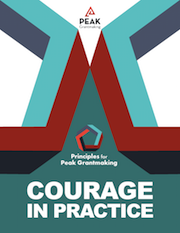
Many in our sector are talking about big ideas such as equity and inclusion, narrowing the power gap in our sector, being authentically engaged in our communities, listening and learning from our partners, and living our values in our practice.
We can help the sector move beyond conversation to action.
We believe our members have the power to bring tangible, real-life, and practical implementation to these big ideas to build a bridge between strategic vision and action. To this end, we support their professional growth through developing the competencies that will help them lead this change.
The New Jersey Council for the Humanities (NJCH) recently awarded $202,840 in Incubation and Action Grant funding to fifteen organizations. Incubation Grants help organizations plan, research, develop, and prototype public humanities projects and events. Action Grants help organizations implement a wide array of humanities-based projects, including public programs, exhibitions, installations, tours, and discussion groups.
Public humanities programming allows individuals to engage in lifelong learning and share in the exploration of history, values, cultures, and beliefs. NJCH supports and acts as a resource for cultural and service-oriented nonprofit partners as they bring the public humanities to the residents of New Jersey, harnessing the power of the humanities to strengthen communities.
The New Jersey State Council on the Arts awarded more than $28 million in grants to support over 700 arts organizations, projects, and artists throughout the state. The grants were approved earlier today at the Arts Council's 56th Annual Meeting.
“It has been an honor to witness the ongoing dedication and boundless creativity of our state’s arts sector,” said Secretary of State Tahesha Way. “I am proud to work closely with the State Arts Council as they grow and innovate, finding new ways to best serve the artists, arts workers, and organizations that continue to engage and inspire communities throughout the state.
Join us for this Health & Aging Affinity Group meeting, a unique opportunity for New Jersey-based funders to connect and share insights on initiatives and strategies related to health and aging. This engaging event will provide a platform for networking, knowledge exchange, and fostering potential partnerships among organizations dedicated to improving the well-being and quality of life for families in our communities. Let's come together to explore innovative solutions, share best practices, and build a stronger, more impactful funding network in the realm of health and aging.
Cost: Free for CNJG Members; $50 for Non Member Grantmakers
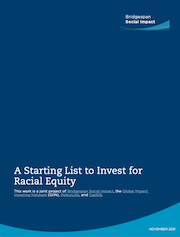
This work is a joint project of Bridgespan Social Impact, the Global Impact Investing Network (GIIN), PolicyLink, and CapEQ.
Since the social unrest over racial injustice in the summer of 2020, philanthropists, corporations, and impact investors across the United States pledged to invest billions of dollars to advance racial equity. However, recent scrutiny of those commitments reveals that the majority of those dollars remain on the sidelines.
A common hypothesis for the shortfall is the lack of investable “shovel-ready” opportunities. But Bridgespan Social Impact has formally and informally advised organizations seeking to invest for racial equity over the years, and found that hypothesis to be patently untrue. To make the case, Bridgespan is publishing this list of racial-equity funds that emerged from our experience, at the request of multiple funds and potential investors, and alongside the launch of a new racial-equity theme in the IRIS+ family of impact measurement and management guides. It comprises more than 160 funds that explicitly seek to improve the livelihoods of individuals who are Black, Indigenous, and people of color (BIPOC) and their communities. And we’re not done yet.
What is racial-equity investing?
In putting together this list, we chose to characterize “racial-equity investing” as directing capital toward creating equitable opportunities for BIPOC individuals and communities. That often requires shifting decision-making power and redefining risk so that capital flows more freely in service of those opportunities.
Sourcing these funds, we uncovered dozens of creative financing vehicles aimed at building power, creating economic opportunity, and improving livelihoods for communities of color.
A corporate member asked for what other corporations do regarding employee’s goal and objectives. Do they include volunteerism or volunteer activities as part of an employee’s review, or their annual goals?
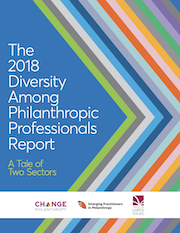
Seeking ways to maximize the social and economic returns of their place-based impact investments, foundations, CDFIs, private investors, and others are turning to collaboration. To support these efforts and facilitate lesson sharing, the Urban Institute and Mission Investors Exchange have produced a set of three practitioner briefs designed to focus on elements of place-based impact investing that have surfaced in research and conversations with practitioners as opportunities for knowledge exchange: building strong ecosystems, mapping opportunities and capacities, and deploying capital on the ground together through impact investing collaborations. Each brief presents the concept, highlights practitioner examples, and elevates lessons from the field.
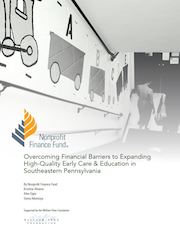
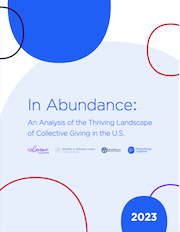
In Abundance: An Analysis of the Thriving Landscape of Collective Giving in the U.S. explores the transformative impact of collective giving on philanthropy. Practiced in cultures all around the world, collective giving brings people together to pool their resources, including time, talent, treasure, testimony, and ties — often referred to as the 5Ts. Groups like giving circles, SVP chapters, giving projects, and nonprofit-led circles have long served as democratic and philanthropic learning hubs — bringing historically marginalized voices into philanthropic decision-making spaces, challenging preconceived notions of who is considered a philanthropist, and elevating members as integral actors in our sector’s efforts to advance diversity, equity, and inclusion in giving.
A partnership between the Johnson Center, Colmena-Consulting, and Philanthropy Together, this report underscores collective giving groups’ role in reshaping philanthropic practices, fostering social connections, and amplifying the voices of marginalized communities.
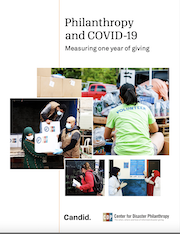
As of February 22, 2021, the coronavirus pandemic has claimed the lives of more than 2.5 million people around the world, with an additional 110 million people infected. And while data such as this serves an enormous purpose in understanding the scale and scope of a disaster, aiding experts in determining needs and directing resources, it remains far from the complete picture of the impact of COVID-19 on humanity.
Philanthropy’s response to the COVID-19 pandemic demonstrates that not only can donors be exceedingly generous in a crisis, but they can lead through trust and courage. In this new report, the Center for Disaster Philanthropy and Candid recognize this leadership, as demonstrated by increased overall giving, even if too little of it is in the form of unrestricted grants and funds directed toward Black, Indigenous, and other communities of color. There remains much to be done, especially regarding support for programs that deliver the policy and system changes necessary to redress generations of inequities.

